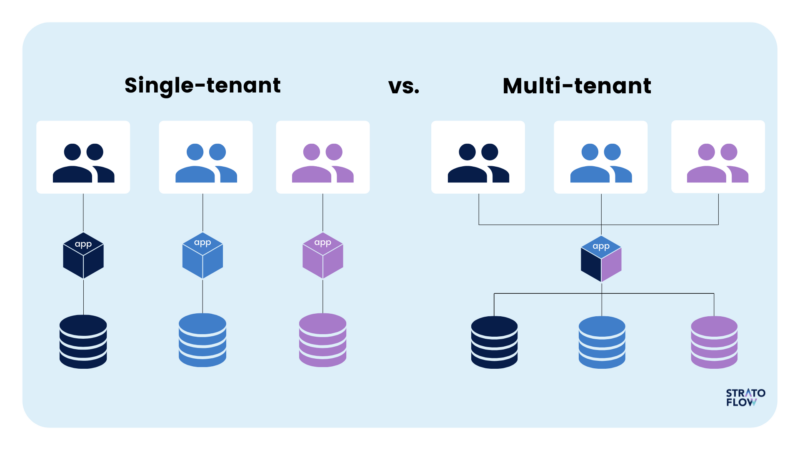When designing a Software as a Service (SaaS) application, one of the most critical architectural decisions is choosing between a single-tenant or multi-tenant architecture. This decision affects scalability, security, cost, and maintenance. In this tutorial, we’ll explore the key differences, advantages, disadvantages, and use cases for each approach.
What is Single-Tenant Architecture?
In a single-tenant architecture, each customer (or tenant) has their own dedicated instance of the application and database. Think of it as providing a private, isolated environment for every tenant.
Key Features:
- Dedicated Resources: Each tenant gets a separate application instance and database.
- Customizable: Easy to offer tenant-specific customizations.
- Isolated Data: Enhanced security due to separate data stores.
Advantages:
- High Security: Data breaches in one tenant do not affect others.
- Performance Isolation: Resource usage by one tenant does not impact others.
- Easy Debugging: Tenant-specific issues are easier to isolate and fix.
Disadvantages:
- Higher Costs: Separate instances mean increased infrastructure and maintenance costs.
- Scaling Challenges: Scaling requires provisioning resources for each tenant.
- Complex Maintenance: Updating or patching multiple instances can be tedious.
What is Multi-Tenant Architecture?
In a multi-tenant architecture, multiple customers share the same application instance and database, with data segregated using logical isolation.
Key Features:
- Shared Resources: All tenants share the same application instance and database.
- Centralized Management: Easier to maintain and deploy updates.
- Logical Data Isolation: Tenant data is separated logically, often using unique tenant IDs.
Advantages:
- Cost Efficiency: Shared infrastructure reduces operational costs.
- Easier Scaling: A single instance can scale to accommodate multiple tenants.
- Simplified Upgrades: Updates are applied once for all tenants.
Disadvantages:
- Data Security Risks: Logical separation makes it vulnerable to data leaks if not implemented correctly.
- Performance Contention: Resource usage by one tenant can impact others.
- Limited Customization: Harder to provide tenant-specific features or configurations.
Shared Schema for Tenants
An extension of multi-tenant architecture is the use of a shared schema to manage tenants. This approach uses a single database schema to store data for all tenants, with tenant-specific data logically separated using unique identifiers.
Key Features:
- Unified Schema: A single schema is used for all tenants, with tables including a
tenant_idcolumn to distinguish records. - Centralized Maintenance: Database changes, such as schema updates, are simpler and consistent across all tenants.
Advantages:
- Efficient Resource Usage: Simplifies database management by reducing the need for multiple schemas or databases.
- Scalability: Ideal for applications expecting a high number of tenants with similar requirements.
- Cost Reduction: Lowers infrastructure costs compared to maintaining separate schemas or databases.
Disadvantages:
- Complex Query Management: All queries must include filtering by
tenant_idto ensure data isolation. - Potential Performance Issues: High-volume tenants can impact overall database performance.
- Security Risks: Misconfigurations could lead to accidental data exposure between tenants.
Use Cases:
- SaaS applications targeting small-to-medium businesses where cost efficiency and scalability are critical.
- Multi-tenant systems with standardized features and minimal customization needs.
Key Considerations for Choosing the Right Architecture
1. Security Requirements
- Choose single-tenant for highly sensitive data (e.g., healthcare or finance).
- Multi-tenant can suffice if robust logical isolation is implemented.
2. Cost Constraints
- Opt for multi-tenant to minimize infrastructure and operational costs.
- Single-tenant might be feasible for high-value customers who can bear the cost.
3. Scalability Needs
- Multi-tenant scales better for SaaS platforms expecting rapid growth.
- Single-tenant requires scaling each instance individually, which can be cumbersome.
4. Customization
- Single-tenant allows for high customization, ideal for enterprise clients.
- Multi-tenant is better suited for standardized solutions.
Transitioning Between Architectures
Moving from Single-Tenant to Multi-Tenant
- Data Segregation: Implement tenant identifiers to separate data logically.
- Shared Resources: Refactor the application to support resource sharing.
- Testing: Ensure that security and performance are not compromised.
Moving from Multi-Tenant to Single-Tenant
- Database Splitting: Separate shared databases into individual instances.
- Deployment Automation: Use tools to automate provisioning and scaling.
- Infrastructure Planning: Prepare for increased infrastructure costs.
Real-World Use Cases
Single-Tenant SaaS Examples
- Enterprise Resource Planning (ERP): Large enterprises with specific customization needs.
- Government Applications: High-security environments requiring isolation.
Multi-Tenant SaaS Examples
- Email Marketing Tools: Platforms like Mailchimp.
- Project Management Tools: Applications like Trello or Asana.
Conclusion
Choosing between single-tenant and multi-tenant architectures depends on your SaaS product’s specific requirements, such as security, cost, scalability, and customization. By understanding the strengths and limitations of each approach, you can make informed design decisions that align with your business goals.


Leave a Reply